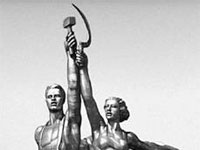Fall of the Berlin wall - repercussions in the USSR
The scattering of the USSR
by Jan van der Made
Article published on the 2009-11-04 Latest update 2009-11-05 12:17 TU
When Berlin Wall euphoria swept through the states of what was still known as the Warsaw Pact, Russian republics bordering Eastern Europe followed the process with intense interest. But unlike Poland, East Germany and Hungary, they were not quick in breaking away from Moscow’s control.
Chris Brown, professor of International Relations at the London School of Economics says that the then USSR Communist Party leader Mikhail Gorbachev wasn’t ready for it.
“Clearly the point of the fall of the Berlin wall was that Gorbachev was prepared to throw the East German regime to the wolves, if you can put it that way,” he says, “but in 1989 he wasn’t yet prepared to let the republics go. So there wasn’t a direct effect in that way, but certainly the atmosphere gave a great deal of heart to those nationalist movements and independence movements within the Baltic republics for example.”
And it was in the Baltic states that the voice for independence was strongest.
André Gerrits, a professor at the University of Amsterdam, thinks the long-term impact of the fall of the Berlin Wall was crucial in the way that people regarded the power of communism.
"It was a proof that in the history of the Soviet Union - communism - that included the country as a communist superpower, had reached the end stage of its development,” he says.
Mass protests started in the early 1990s in the Baltic states. However the fourteen states that made up the Soviet Union had different ideas about their future.
Brown says that for the Asian republics things were less clear. “If you sat down in November 1989, I think you would have predicted an independent Estonia fairly quickly, I don’t think you’d have necessarily predicted an independent Kazakhstan,” he says.
Analysis: Soviet republics after the Berlin Wall
Georgia and Armenia, and the Baltic states were more nationalistically inclined than some of the other former Soviet republics, where there were stronger independence or movements for sovereignty. Gerrits even believes that “the republics in Central Asia were concerned about the potential dissolution of the Soviet Union,” because the protectionist umbrella provided by Moscow would disappear.
The former Soviet republics eventually organised themselves into the Commonwealth of Independent States or CIS. All former USSR republics except for the Baltic states became members when the Soviet Union officially dissolved at the end of 1991.
They might have been afraid that the CIS was implicitly designed as yet another Moscow-dominated structure. But that wasn’t the intention of the organisation, says Gerrits, who sees it as a "loose structure that was, on the contrary, designed to help dissolve the USSR".
Georgia left the CIS in 2008, after its brief war with Russia, but the rest of the former Soviet states still remain as members.
Meanwhile, the fall of the Berlin Wall and the dissolution of the Soviet empire into fourteen independent states was a blow to popular theories on international relations.
For example, the theory of a bipolar world, lost its meaning. And Marxism, for seventy years the guiding political philosophy in the former Soviet Union, saw its appeal shrinking.
But professor Herman Schwartz, a political economist with the University of Virginia, says the dissolution of the USSR was in fact predicted by some Marxists.
The fall of the Soviet Union, “revealed that the system of pure state ownership was not going to work at an economic level,” he says.
Schwartz adds, “Marxist theorists have argued that there was not really a balance of power, not really a bipolar world, even after 1945 [...] there was a competition among models, and the relatively unregulated economies of the west, and the planned economy around the Soviet Union.”
Not only did many former Soviet republics embrace democracy (notable exceptions were Belarus and Turkmenistan), three of them (the Baltic states) became full-fledged Nato and EU members, while two others (the Ukraine and Georgia) were promised invitations to become member of the alliance.
Why did Nato, after the fall of the Berlin Wall and the dissolution of the USSR, not disappear? According to Schwartz, Marxist theorists see this as the ultimate proof that, “the purpose of Nato was not just to keep the Soviet Union in its place, but also to make sure that the US could dominate Europe militarily, and prevent western Europe as a peer military rival.”






